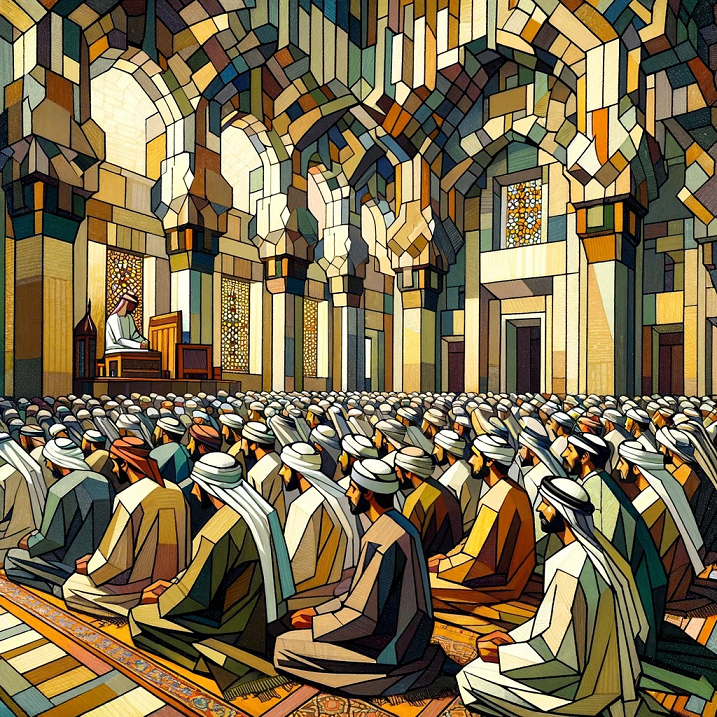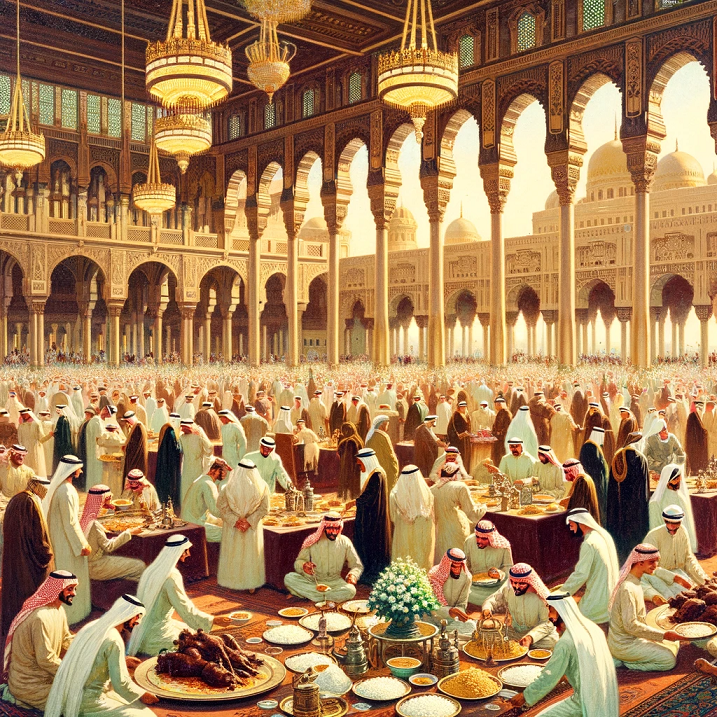In the realm of Western explorations into the Arabian Peninsula, the works of adventurers like Harry Philby, particularly his “Arabia”, have long been a source of fascination for those interested in the nascence of the Saudi state. These explorations, often intertwining with the culture and politics of Riyadh and its surrounding areas, have shed light on the intricate dynamics of places, people, and tribes within Arabia.
Key Takeaways
- The moon sighting controversy during ‘Id underscored the interplay between science and religion in Riyadh.
- Ibn Nimr’s dispute during ‘Id illustrates the sensitivity around religious practices and the decisive leadership of Ibn Sa’ud.
- Eid celebrations in Riyadh were a vibrant display of communal joy, cultural richness, and religious devotion.
The Ordeal of Ramdhan and Its Impact on Philby’s Stay
Philby’s narrative takes a compelling turn as he delves into the unique experiences surrounding the holy month of Ramdhan in Riyadh. This period significantly shaped his stay, offering a blend of introspection and cultural immersion.
During Ramdhan, Philby observed a stark reduction in social activities, leading to a somewhat isolated existence. This time, however, was not spent in idleness. Instead, Philby found himself engrossed in addressing the backlog of official work that had piled up during his travels. This period of relative solitude provided him with ample opportunity to reflect on the outcomes of his recent journey and assess the evolving political and military landscapes resulting from recent developments in various regions.
Eid Celebrations: A Vibrant Tapestry of Culture and Community
The culmination of Ramdhan brought with it the vibrant and eagerly anticipated celebrations of ‘Id in Riyadh, a time when the city transformed into a hub of communal joy and religious fervour. Harry St. John Philby’s observations during these festivities offer a vivid snapshot of Arabian culture in its most spirited form.

The break of dawn on eid saw Riyadh awakening in a festive mood, with residents donning their finest attire in anticipation of the day’s events. The day commenced with a large congregation gathering for the special ‘Id prayers outside the city’s northeast gate, a testament to the community’s devoutness and unity. Philby notes the inclusivity of the occasion, with the entire male population participating in the prayers, followed by a sermon by Ibn Sa’ud, further cementing the sense of communal bonding and shared religious devotion.
Post-prayer, the celebratory atmosphere continued as the crowd returned to the palace for a grand feast. This event was not just a culinary indulgence but a significant social gathering, reinforcing the communal ties within Riyadh. The palace courtyard, usually a place of political discussions and decisions, transformed into a lively banquet hall, where trays of rice and mutton were served to the guests. The act of sharing a meal, a powerful symbol of community and brotherhood, was vividly captured by Philby in his descriptions.
The crowd then streamed back to the palace, where countless trays of rice and mutton awaited the guests in the great courtyard of the section of the palace in which were my apartments. As each man finished he rose from his place, licking his fingers, which, as he passed through the small courtyard in front of my window, he dipped into a great cauldron of water placed there for the purpose. And so, one after another in a never-ending stream, they passed on, drying their hands on their holiday garments or against the mud-walls of the courtyard, to the great audience-chamber, where Ibn Sa’ud sat in state to receive their homage.
St. John Philby: Arabia

Controversy and Resolution during Ramdhan and ‘Id
As Ramdhan drew to a close, Philby found himself amidst a unique controversy that highlighted the deep religious sensitivities within Riyadh. His prediction about the sighting of the new moon, based on the Nautical Almanac, brought him into the complex interplay of religion, tradition, and astronomy that governs Islamic festivals.
And so the month of Ramdhan dragged on slowly but surely to its weary end. On 7th July, equivalent to 28th Ramdhan Ibn Sa’ud was talking generally of the severity of the fast and wondering whether the moon would appear on the following night. Having already carefully studied the Nautical Almanac and ascertained that the moon would be old enough to show under favourable conditions, I made bold to predict that the following evening would usher in the ‘Id in spite of the expectation of the local ‘ wise men ’ that there would be a thirtieth day to this Ramdhan.
St. John Philby: Arabia
The anticipation for the end of Ramdhan was palpable, with people eagerly awaiting the moon’s appearance to mark the commencement of ‘Id. When the moon did not appear as Philby had predicted, it not only led to a collective sense of disappointment but also cast a shadow of doubt over his astronomical calculations. This incident underscored the precarious balance between scientific predictions and religious observances.
Many of the crowd were women, who are credited with keener sight than men, and I had an uncanny feeling that my prediction of the probable appearance of the moon was known to many of the watchers who, in spite of the extra day’s fast involved, would be almost glad to have the infidel’s impudence confounded by a manifestation of divine arbitrariness.
St. John Philby: Arabia
The resolution of this celestial dilemma came unexpectedly when Bedouins from Dakina reported the sighting of the crescent moon. This announcement, leading to the abrupt end of the Qiyam prayers and the jubilant declaration of ‘Id, brought immense relief and joy to the populace. Philby’s observations of these events provide a vivid portrayal of the intense spiritual fervour and the communal aspect of religious celebrations in Riyadh.
Some Badawin of Dakina had come in post-haste to report that they had seen the crescent of the new moon and had been sent to the chief Shaikh, ’Abdullah Ibn ’Abdul Wahhab, who had immediately assembled an ecclesiastical court consisting of himself and two Qadhis to take the evidence of the new arrivals. They had pronounced themselves entirely satisfied, and the gunshot, which had awakened me, was the first announcement to the people of Riyadh that the morrow would be celebrated as the ‘Id.
St. John Philby: Arabia

However, the festive spirit was momentarily disrupted by a religious dispute instigated by Ibn Nimr, a chief divine and chaplain to Ibn Sa’ud. His accusation against the Ikhwan for fasting on ‘Id, motivated by a personal grievance, created significant distress. The swift intervention of Ibn Sa’ud, resulting in Ibn Nimr’s temporary imprisonment, highlighted the leader’s decisive approach in maintaining social harmony and religious order. This incident not only resolved the controversy but also served as a cautionary tale about the misuse of religious authority in Saudi Arabian society.
Ibn Nimr was sent for to explain his attitude. He appeared unrepentant and adopted an attitude that was both impertinent and defiant. And he found himself without further ado inside the jail, where incidentally the Turkish officer, Qudsi Effendi, captured on his way from the Yaman across the desert to Syria during the previous April, was apparently still eating out his heart in solitary confinement.
A few hours of a similar experience were sufficient to persuade Ibn Nimr of the error of his ways, but his piteous screams for mercy found no path to the heart of Ibn Sa’ud. He was released a few days later a sadder and a wiser man, and his example served to warn the ‘Ulama of Arabia that the creation of distress in the minds of the public was not a legitimate weapon in the controversies arising out of their constant striving for precedence.
St. John Philby: Arabia
Harry St. John Philby’s sojourn in Riyadh, as chronicled in his accounts, offers a compelling glimpse into the socio-political and cultural landscape of early 20th-century Saudi Arabia. His experiences provide an invaluable perspective on a region undergoing profound transformation. The vivid portrayal of events, coupled with Philby’s astute observations, enriches our understanding of this period in Saudi Arabia’s history.
FAQ
Q: What was the significance of the moon sighting incident?
A: The incident highlighted the complexities of aligning scientific predictions with religious observances in Arabian culture.
Q: Who was Ibn Nimr and what controversy did he cause?
A: Ibn Nimr was a religious figure who caused distress by wrongly accusing the Ikhwan of fasting on ‘Id, leading to his temporary imprisonment.
Q: How did Philby describe the ‘Id celebrations in Riyadh?
A: Philby portrayed ‘Id as a time of communal bonding, religious fervor, and cultural celebration in Riyadh.
Q: What does Philby’s account reveal about early 20th-century Saudi Arabia?
A: Philby’s narrative offers insights into the social customs, religious practices, and leadership dynamics of the era.

